Injurious pecking behavior of poultry

- Pain
- Damage to the feathers and skin
- Death in extreme cases
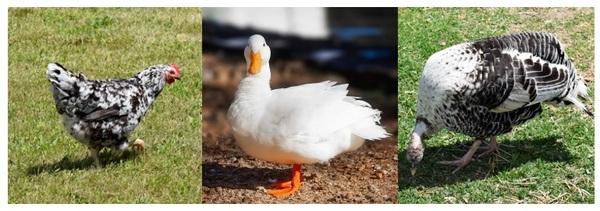

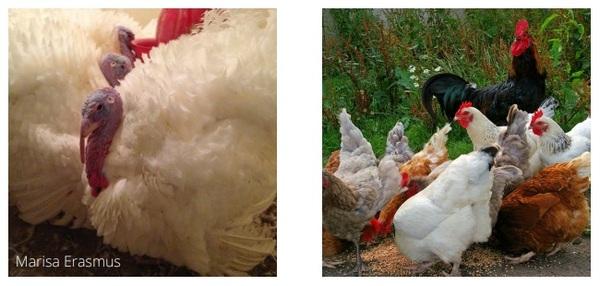
- Diets that are deficient in some nutrients (protein, amino acids, or minerals) may increase injurious pecking. Severe feather pecking has been found to occur in birds that are fed a diet too low in minerals, protein, or amino acids (methionine, arginine).
- Injurious feather pecking may occur when birds are fed a diet with mainly vegetable protein sources
- Birds that are restrict-fed sometimes develop injurious feather pecking behavior
- Injurious feather pecking behavior of laying hens seems to occur less frequently if hens are able to spend more time foraging and eating feed
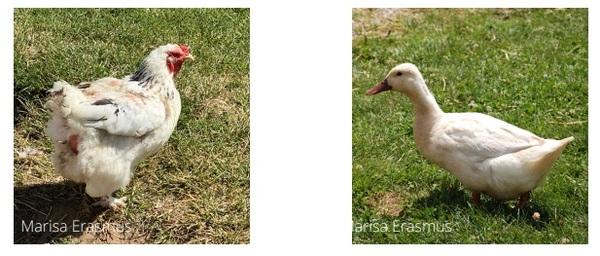
- Better ability to cope with challenging conditions
- Reduced occurrence of harmful behaviors such as severe feather pecking
- Reduced negative affective states such as fearfulness
- Improved productivity and health
- Greater variety of behaviors. Some environmental enrichment allows the birds to perform behaviors they are strongly motivated to perform.
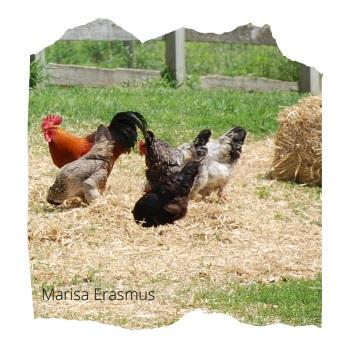 Pecking enrichment
Pecking enrichment- Housing birds in environments with suitable foraging substrates is important. Birds not provided suitable substrate would perform sham forage.
- Pecking string (that cannot be swallowed) has been shown to be effective in reducing feather pecking in laying hens.
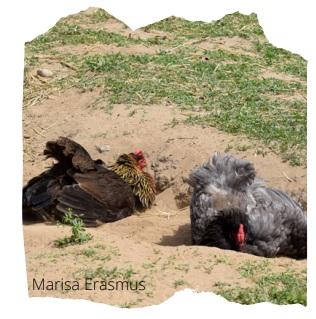 Dustbathing enrichment and novel objects
Dustbathing enrichment and novel objects- Providing material for dustbathing and novel (unfamiliar) objects, may be effective in reducing feather pecking
- For ducks, providing swimming water or a source of water that is at least deep enough for them to immerse their heads and shake water over their body can help them to maintain good plumage, nostril, and eye condition. If these types of water sources are provided for wet preening, it is important that the water is clean and of good quality, because contaminated water can pose health risks to the birds, leading to illness
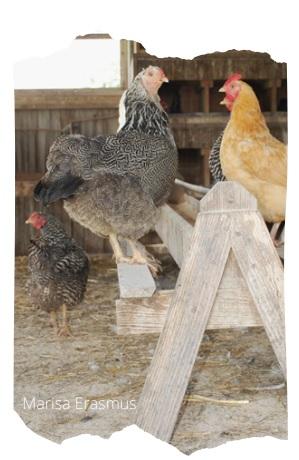 Spatial Configuration
Spatial Configuration- Changing the space that the birds are kept in can impact the birds’ perception, change how they use the space, and may influence their social behavior
- Chickens may use a larger area of their environment when provided with vertical barriers
- Increasing vertical space by providing a hay bale or perches, for example, could provide a comforting space for chickens because they are naturally motivated to perch
- Injurious pecking can cause welfare issues to affected poultry
- Injurious pecking includes severe feather pecking, feather picking, aggressive pecking, and cannibalism
- Feeding management (appropriate amount, form and nutrient composition), lighting management (light intensity, photoperiod, and light source) and providing environmental enrichment (pecking enrichment, dustbathing enrichment, water enrichment for waterfowl, novel objects and special configuration) can help reduce or prevent injurious pecking in poultry, but the types and effectiveness of different strategies may vary among species
Bilcik, B., and L. J. Keeling. 1999. Changes in feather condition in relation to feather pecking and aggressive behaviour in laying hens. British Poultry Science. 40:444–451.
Blokhuis, H. J. 1989. The development and causation of feather pecking in the domestic fowl. PhD Diss. Wageningen University in The Netherlands.
Blokhuis, H., and P. Wiepkema. 1998. Studies of feather pecking in poultry. Veterinary Quarterly. 20:6–9.
Bordnick, P. S., B. A. Thyer, and B. W. Ritchie. 1994. Feather picking disorder and trichotillomania: An avian model of human psychopathology. Journal of Behavior Therapy and Experimental Psychiatry 25:189–196.
Bright, A. 2007. Plumage colour and feather pecking in laying hens, a chicken perspective? British Poultry Science 48:253–263.
Classen, H. L., C. Riddell, F. E. Robinson, P. J. Shand, and A. R. McCurdy. 1994. Effect of lighting treatment on the productivity, health, behaviour and sexual maturity of heavy male Turkeys. British Poultry Science 35:215–225.
Colton, S., and G. S. Fraley. 2014. The effects of environmental enrichment devices on feather picking in commercially housed Pekin ducks. Poultry Science. 93:2143–2150.
Daigle, C. L., T. B. Rodenburg, J. E. Bolhuis, J. C. Swanson, and J. M. Siegford. 2014. Use of dynamic and rewarding environmental enrichment to alleviate feather pecking in non-cage laying hens. Applied Animal Behaviour Science. 161:75–85.
Daigle, C. L. 2017. Controlling Feather Pecking and Cannibalism in Egg Laying Flocks. Egg Innovations and Strategies for Improvements:111–121.
Dalton, H., B. Wood, and S. Torrey. 2013. Injurious pecking in domestic turkeys: development, causes, and potential solutions. Worlds Poultry Science Journal. 69:865–876.
Dixon, L. M. 2008. An investigation into the motivation behind the abnormal behaviour of feather pecking in laying hens. PhD Diss. University of Guelph.
Dixon, L. M., I. J. H. Duncan, and G. Mason. 2008. What’s in a peck? Using fixed action pattern morphology to identify the motivational basis of abnormal feather-pecking behaviour. Animal Behaviour 76:1035–1042.
Dong, Y., D. Karcher and M. Erasmus. 2019. An explanation of damaging pecking behavior in poultry and captive birds. Purdue University Extension Publication AS-651-W.
Duncan, I. J. H. and P. Hawkins. 2009. The welfare of domestic fowl and other captive birds. Page 83 in The welfare of domestic fowl and other captive birds. Springer, Dordrecht.
Faber, H. V. 1964. Feather Eating as Stressor in the Muscovy Duck. Poultry Science. 43:1432–1434.
Hoffmeyer, I. 1969. Feather pecking in pheasants: an ethological approach to the problem. Vildtbiologisk Station, Kalø, Denmark.
Hubrecht, R., and J. Kirkwood. 2010. The UFAW Handbook on the Care and Management of Laboratory and Other Research Animals. Wiley, Hoboken.
Hughes, B. O., and I. J. H. Duncan. 1972. The influence of strain and environmental factors upon feather pecking and cannibalism in fowls. British Poultry Science. 13:525–547.
Jones, R., T. Mcadie, C. Mccorquodale, and L. Keeling. 2002. Pecking at other birds and at string enrichment devices by adult laying hens. British Poultry Science. 43:337–343.
Jones, T. A., C. D. Waitt, and M. S. Dawkins. 2009. Water off a duck’s back: Showers and troughs match ponds for improving duck welfare. Applied Animal Behaviour Science 116:52–57.
Kjaer, J., P. Sørensen, and G. Su. 2001. Divergent selection on feather pecking behaviour in laying hens (Gallus gallus domesticus). Applied Animal Behaviour Science. 71:229–239.
Klemm, R., Reiter, K., and Pingel, H. 1995. Investigations on feather pecking in Muscovy ducks. Archiv Fur Geflugelkunde. 59: 99-102.
Lambton, S. L., T. G. Knowles, C. Yorke, and C. J. Nicol. 2010. The risk factors affecting the development of gentle and severe feather pecking in loose housed laying hens. Applied Animal Behaviour Science 123:32–42.
Martrenchar, A. 1999. Animal welfare and intensive production of turkey broilers. Worlds Poultry Science Journal. 55:143–152.
Mason, G. J., Dixon, L. M., and Duncan, I. J. H. 2010. The effects of four types of enrichment on feather pecking behaviour in laying hens housed in barren environments. Animal Welfare. 19: 429– 435.
Mcadie, T., and L. Keeling. 2000. Effect of manipulating feathers of laying hens on the incidence of feather pecking and cannibalism. Applied Animal Behaviour Science. 68:215–229.
Mellor, E., B. Brilot, and S. Collins. 2018. Abnormal repetitive behaviours in captive birds: a Tinbergian review. Applied Animal Behaviour Science 198:109–120.
Miller, K., and J. Mench. 2006. Differential effects of 4 types of environmental enrichment on aggressive pecking, feather pecking, feather loss, food wastage and productivity in Japanese quail. British Poultry Science. 47:646–658.
Moinard, C., P. D. Lewis, G. C. Perry, and C. M. Sherwin. 2001. The effects of light intensity and light source on injuries due to pecking of male domestic turkeys (Meleagris gallopavo). Animal Welfare 10: 131-139.
Nicol, C. J., M. Bestman, A.-M. Gilani, E. N. De Haas, I. C. De Jong, S. Lambton, J. P. Wagenaar, C. A. Weeks, and T. B. Rodenburg. 2013. The prevention and control of feather pecking: application to commercial systems. World’s Poultry Science Journal 69:775–788.
Prescott, N. B., C. M. Wathes, and J. R. Jarvis. 2003. Light, vision and the welfare of poultry. Animal welfare 12: 269-288.
Riber, A. B., and J. A. Mench. 2008. Effects of feed- and water-based enrichment on activity and cannibalism in Muscovy ducklings. Applied Animal Behaviour Science. 114:429–440.
Rodenburg, T., M. Bracke, J. Berk, J. Cooper, J. Faure, D. Guémené, G. Guy, A. Harlander, T. Jones, U. Knierim, K. Kuhnt, H. Pingel, K. Reiter, J. Serviére, and M. Ruis. 2005. Welfare of ducks in European duck husbandry systems. Worlds Poultry Science Journal. 61:633–646.
Riedstra, B., and T. G. G. Groothuis. 2002. Early feather pecking as a form of social exploration: the effect of group stability on feather pecking and tonic immobility in domestic chicks. Applied Animal Behaviour Science 77:127–138.
Rodenburg, T., M. V. Krimpen, I. D. Jong, E. D. Haas, M. Kops, B. Riedstra, R. Nordquist, J. Wagenaar, M. Bestman, and C. Nicol. 2013. The prevention and control of feather pecking in laying hens: identifying the underlying principles. Worlds Poultry Science Journal. 69:361–374.
Rosskopf, W. J., and Woerpel, R. W. 1996. Feather picking and therapy of skin and feather disorders. Diseases of cage and aviary birds, 397-405.
Savory, C. 1995. Feather pecking and cannibalism. Worlds Poultry Science Journal. 51:215–219.
Sherwin, C. M. 1999. Domestic turkeys are not averse to compact fluorescent lighting. Applied Animal Behaviour Science 64:47–55.
Sherwin, C., and C. Devereux. 1999. Preliminary investigations of ultraviolet-induced markings on domestic turkey chicks and a possible role in injurious pecking. British Poultry Science. 40:429– 433.
Snyder, E. S. 1962. Market Possibilities and Yields of Muscovy Ducks Dressed at Various Ages. Poultry Science. 41:813–818.
Van Krimpen, M. M., Kwakkel, R. P., Reuvekamp, B. F. J., Van Der Peet-Schwering, C. M. C., Den Hartog, L. A., and Verstegen, M. W. A. 2005. Impact of feeding management on feather pecking in laying hens. World's Poultry Science Journal. 61: 663-686.
Vestergaard, K. S., and L. Lisborg. 1993. A Model of Feather Pecking Development Which Relates To Dustbathing in the Fowl. Behaviour. 126:291–308.
Zeeland, Y. R. V., B. M. Spruit, T. B. Rodenburg, B. Riedstra, Y. M. V. Hierden, B. Buitenhuis, S. M. Korte, and J. T. Lumeij. 2009. Feather damaging behaviour in parrots: A review with consideration of comparative aspects. Applied Animal Behaviour Science. 121:75–95.


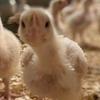









.jpg&w=3840&q=75)